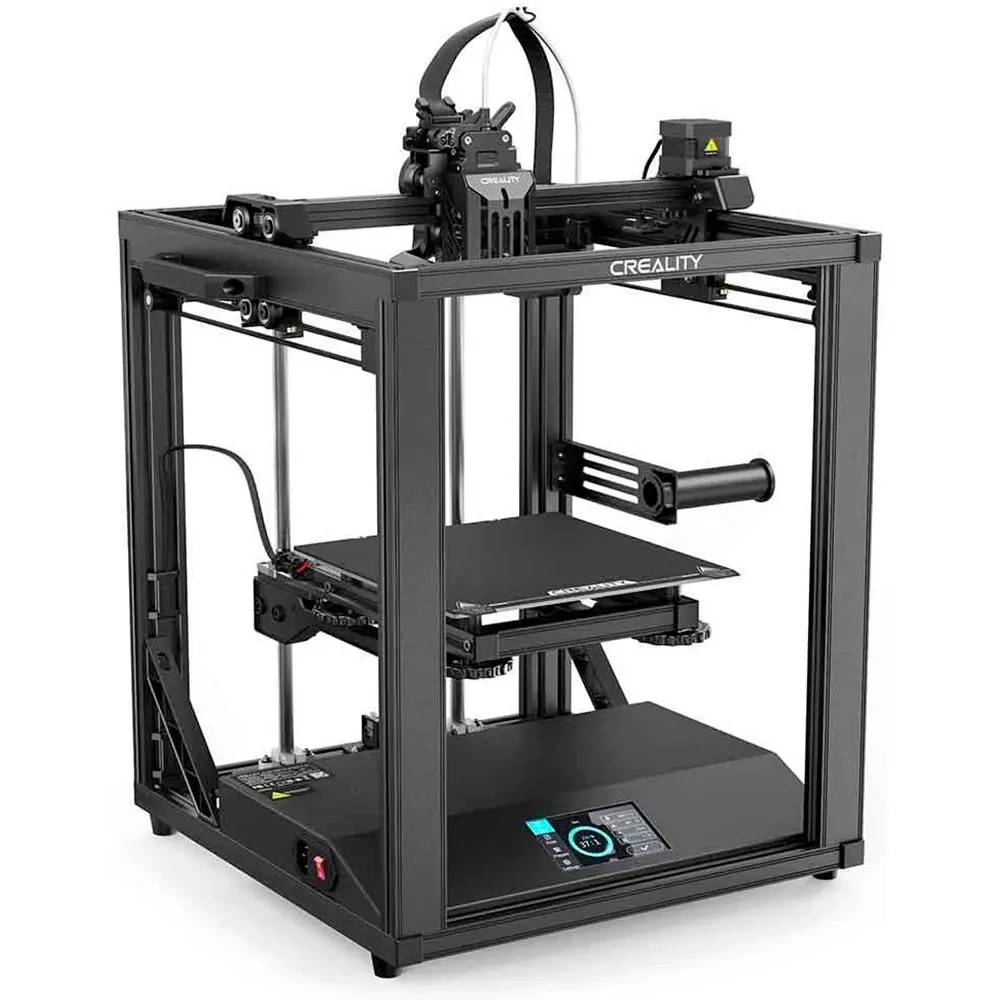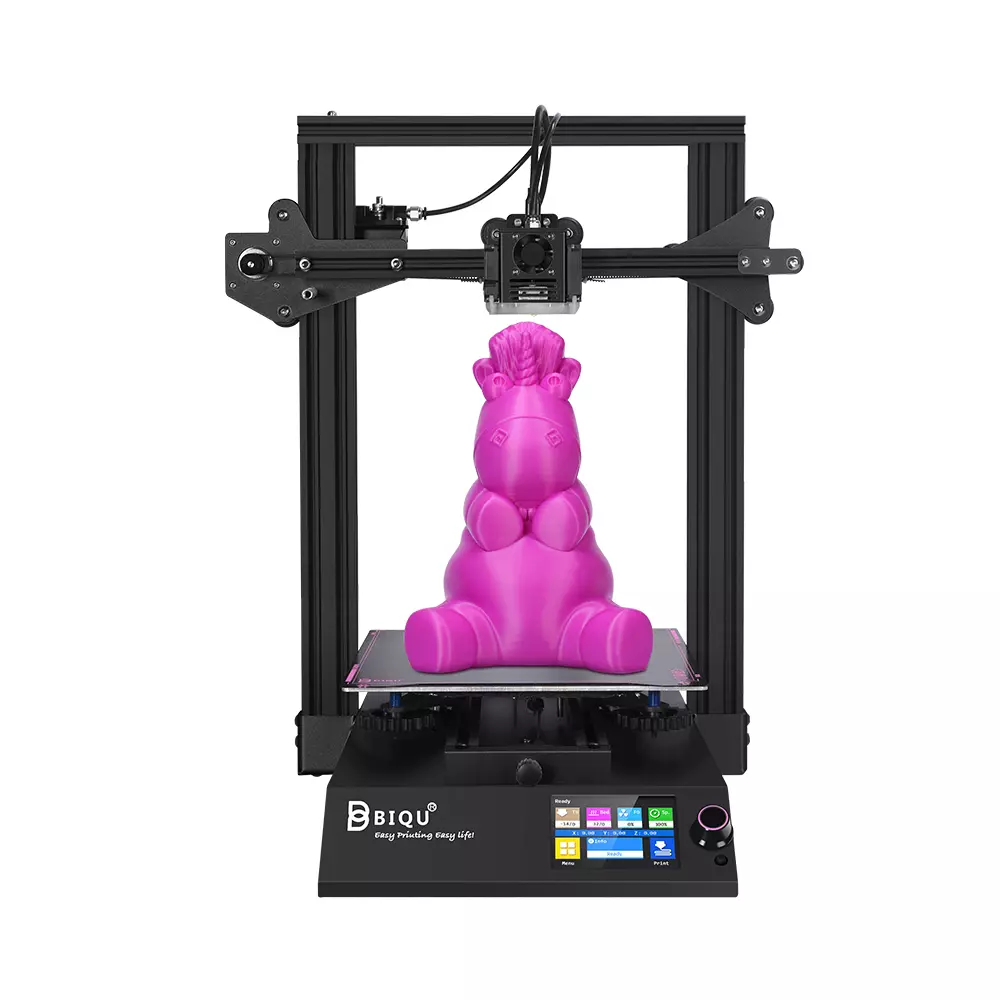Compare Ender 5 S1 vs BIQU B1
Comparison between the best 3D printers
Choose the best 3D printer at the best price. The cheapest 3D printers are here.
Buy a 3D printer here with 3D Fila.
 |
 |
|
| Model | Ender 5 S1 |
BIQU B1 |
| Printing Material | Filament | Filament |
| Buy Filament for Creality 3D Ender 5 S1 | Buy Filament forBigTreeTech BIQU B1 | |
| Estimated price | $467,00 | $269,00 |
| Manufacturer | Creality 3D | BigTreeTech |
| Release Year | 2022 | 2020 |
| Print Volume [mm] | 220x220x280 | 235x235x270 |
| Printer Size [mm] | 425x460x570 | 412x402x492 |
| Weight [kg] | 12,1 | 8,00 |
| Power Loss Recovery | YES | YES |
| Enclosed printer | NO | NO |
| Bed Leveling | Automatic | Manual |
| Filament End Sensor | YES | YES |
| Bed type | Heated | Heated |
| Power supply system | Direct Drive | Bowden |
| Standard nozzle | 0,4 | 0,4 |
| Maximum Nozzle Temperature [°C] | 300 | 250 |
| Maximum Bed Temperature [°C] | 110 | 100 |
| Maximum printing speed [mm/s] | 250 | 100 |
| Filament holder | YES | YES |
| Camera for supervision | NO | NO |
| Recommended filaments | PLA, ABS, PETG, TPU, PC, ASA, HIPS | PLA, TPU, ABS, PETG |
| Recommended slicers | Cura, Simplify, Slic3r, IdeaMaker | Cura, Simplify, Slic3r |
| Maximum Resolution [mm] | 0,05 | 0,1 |
| Processor | 32 Bits | 32 Bits BTT SKR V 1.4 |
| Display | Display touchscreen 4,3 '' | Touchscreen TFT 3,5'' |
| Power Supply | 350 W | 24V / 360W |
| Connectivity | SD / USB / Wi-Fi | SD / USB |
| Operating systems | Windows, Mac, Linux | Windows, Mac, Linux |
| Date of registration in the system | 2023-10-04 | 2021-04-14 |
| Release date | 2022 | 2020 |
| Extra features | A steel drive shaft synchronizes the two Y-axis belts. High-torque 42-48 Y-axis motor for responsive and precise movement. Cartesian structure. Enhanced stability by thick linear shafts, extra stiffeners, two cantilevers, and silicone bumpers. Double Die Spring profile reinforcement. Silicone bed support. All-metal Sprite direct extruder. Best for printing with flexible filaments like TPU. Auto-calibration with 16-point CR Touch. Compatible with Sonic Pad, Wifi Box, and Camera kit. | The BIQU B1 is an advanced 3D printer with a silent 32-bit BTT SKR V1.4 motherboard and ARM Cortex-M3 CPU, offering DIY interfaces (I2C, SPI, WiFi) and dual Z-axis. Its dual BTT B1 TFT35 V3.0 operating system allows real-time monitoring and multiple printing modes, including G-code visualization effects. It stands out for its BIQU SSS (Super Spring Steel), ensuring easy model adhesion and simplified removal, with the possibility of using it on both sides. It includes a filament sensor, automatically pausing printing in case of filament breakage. The multicolored RGB lights integrated into the hotend allow you to view the printing status even at night. Additional notes include the need for a BIQU-specific Type-C cable and extra interfaces for smart filament sensor and BL Touch. |
| Support for multiple colors and materials (AMS and CFS) | NO | NO |
Notes * |
||
| Cost-benefit | 7 / 10 | 7 / 10 |
| Hardware | 2.4 / 10 | 2 / 10 |
| Tela | . | . |
| Print volume | 3 / 10 | 3 / 10 |
| Performance | 2 / 10 | 1 / 10 |
Conclusion |
| ### Conclusion In comparing the **Ender 5 S1** and the **BIQU B1**, both printers exhibit their own strengths and weaknesses that cater to different user needs. The **Ender 5 S1**, produced by Creality 3D, is a more robust choice with superior specifications, including a higher maximum nozzle and bed temperature, significantly faster printing speed, and a finer maximum resolution. Its direct drive system and automatic bed leveling add convenience for users who prioritize ease of use and flexibility with various filament types. The enhanced stability features and build quality favor advanced users seeking precision and reliability for comprehensive printing tasks. While it carries a higher price tag, the overall performance and build quality justify the investment for serious hobbyists or professionals. Conversely, the **BIQU B1**, while more affordable, offers a solid entry point for beginners or those with budget constraints. Its construction emphasizes DIY capability with a variety of connectivity options and a silent motherboard, making it suitable for home environments. However, it features a manual bed leveling system and lower print speeds, which may not meet the expectations of users aiming for advanced applications. The dual Z-axis and unique bed design does provide some advantages for simplicity in model removal and adhesion. Ultimately, the choice between these two models will depend significantly on individual needs. If performance and advanced features are a priority, the **Ender 5 S1** represents a premium investment. Conversely, for users looking for a cost-effective and reliable printer for basic projects, the **BIQU B1** is a commendable option. In summary, both printers perform well in their respective categories, making either a valid choice based on user requirements and budget. |

